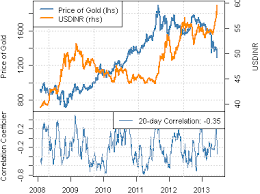
Author: Laxmikant Gupta - SVP, Risk and Compliance - ICICI Ventures. Were you short on US Dollar or long on the same ? Even if you did not have USD, you are exposed to the risk of being Short on Dollar. How ? Rupee Depreciation is increasing your petrol bill, white goods & Gold purchase bills. On the other side, foreign direct investments within the country may slow down, which may have repercussion on job safety / bonuses or increments. In that case, whether exposure to foreign currency is advisable – to hedge against overall domestic currency exposure ? Probably yes, for the sake of diversification and reducing macro risk, though, it may increase micro country level risks. The above are more of economic effect. Come to individual investment effects. If you are getting Rs.1,00,000 worth of ESOPs of your multinational employer’s foreign company listed in US, you are having long position on your USD holding. On the other side, if you have borrowing to pay in USD, you have short position in USD. If long on USD, appreciation in USD will benefit you while its depreciation is a risk. If short on USD, appreciation in USD will is a risk while its depreciation will benefit. Exporters / investors are long on USD while importers / borrowers are short on USD in general. How to avoid risk of forex movement, keeping in mind benefits on the other side. Buying / selling dollar forward or currency option may help to some extent but not always. Buying / selling dollar forward are taking opposite position which may be risk and reward neutral and may not serve the purposes all the time unless there is a gain from basis risk or maturity mis-match risk. Currency Options are pure risk protection product with higher cost. Buying an option is like buying protection with a cost while selling an option is taking huge currency bets. Buying Out of Money options in USD means you are “buying sentiments or volatility” of the country risk and feel that the country will be a “happening place with high level of sentimental flows” and increased volatility. If you are selling Out of Money options in USD, you are “short on sentiments and volatility”. In that case, you feel that the situation is in cooling mode and volatility will reduce. Ignoring options and futures markets, just by spot positions, you may control your risk levels just by using disciplined approach of monitoring VaR limit and Stress Loss Limit. You may set your daily MTM loss limit upto a figure routinely acceptable to you (should be normally equivalent to 6/12 months earning or 20% of forex portfolio but it can be different for different entities and situations). Stress loss limit means regularly applying a stress scenario to your portfolio and monitoring whether it is creating a major hole within your domestic or forex networth. E.g. apply a stress scenario that USD may fall by 10%. Even without forex portfolio, stress scenario of 10% fall in INR is also a good forex risk management tool, to guide whether there is a need to buy any foreign asset. These loss limits (VaR and Stress Loss) can do a lot more without the need of hedging tools provided these are maintained at scientifically appropriate levels and regularly monitored. ************ Please contact the author by email at laxmikantgupta4@rediffmail.com for more information on forex risk management.
